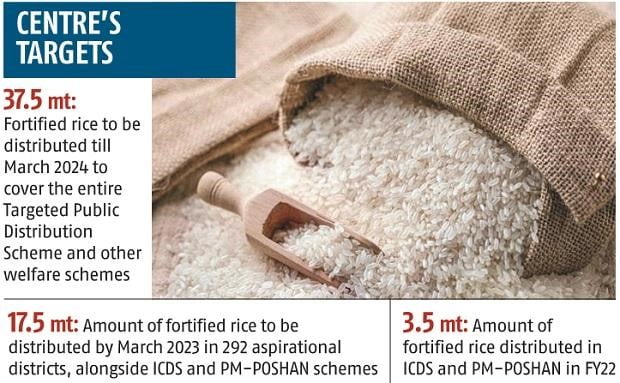Governance
Context: Distribution of iron fortified rice through government schemes as a “silver bullet” to curb anaemia must stop in States like Jharkhand, which have large tribal populations that suffer from sickle-cell anaemia, thalassemia, and tuberculosis, for whom an overload of iron can create adverse health issues, warn activists –
- Neither field functionaries nor beneficiaries had been educated about the potential harms
- There were no warning labels despite the food regulator’s rules on fortified foods.
- Where fortified rice is being distributed under Central government-funded schemes such as the public distribution system (PDS); PM-Poshan (erstwhile mid-day meal scheme) at schools; and Integrated Child Development Services (ICDS or anganwadi services), consent is not being obtained from beneficiaries.
The Effects
Jharkhand is an endemic zone of sickle cell disorder and thalassemia, with a prevalence of 8%-10%, which is twice the national average. Jharkhand is also an endemic zone for malaria — in 2020, the State ranked third in the country in malaria deaths.
- Thalassemia, sickle cell anaemia and malaria are conditions where there is already excess iron in the body, whereas TB patients are unable to absorb iron.
- Consumption of iron-fortified foods among patients of these diseases can reduce immunity and the reduce functionality of organs.
- In a large-scale approach to rice fortification like the one being adopted by governments right now, even a screening process prior to fortified rice distribution does not resolve the problem of at-risk individuals because, within a household, it is unlikely that two different kinds of rice (fortified and unfortified) will be cooked for every meal for the contra-indicated cases and healthy persons.
- It is also unlikely that the government would be able to put into place any mechanisms by which entitlements of each person in a household can be distributed distinctly in the PDS system as fortified and non-fortified rice to cater to individual needs and medical conditions.

The Way Ahead
Nutrition cannot be approached through a micronutrient-by-micronutrient formula and needs a holistic approach.
- Supply and distribution of iron fortified rice should stop in Jharkhand, and the State government must reject rice fortification in government food schemes as an approach to tackling malnutrition.
- Promoting diet diversity by adding millets, pulses and eggs to the PDS is recommended.
- The number of Indians with such diseases is significant, and most are not even aware that they have such conditions. In this one-size-fits-all solution, fortified rice is being pushed onto unsuspecting citizens who have not given their prior informed consent.
- Large scale fortification will lead to irreversible market shifts, with concomitant infrastructure changes in the supply chain.
- On the other hand, protein-rich diets, millets, healthy fats, traditional kinds of rice that are nutritionally superior, staple grains that are traditionally processed to preserve their nutrients, local (uncultivated) greens, diverse forest foods, and other materials can come from millions of kitchen gardens and other locally-led efforts, will all be neglected by such a policy.
Fortified Rice
- Fortification is the addition of key vitamins and minerals such as iron, iodine, zinc, Vitamin A & D to staple foods such as rice, milk and salt to improve their nutritional content. These nutrients may or may not have been originally present in the food before processing.
- Fortification of Rice: According to the Food Ministry, fortification of rice is a cost-effective and complementary strategy to increase vitamin and mineral content in diets.
Source: Hindustan Times














